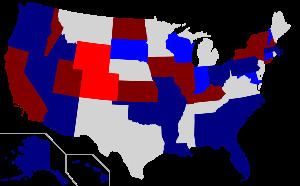Montana Illinois 63 37 3 3 Start date November 6, 1962 | 64 seats 36 seats 66 34 20,832,503 20,245,509 | |
 | ||
Winner Mike Mansfield | ||
The United States Senate elections, 1962 was an election for the United States Senate which was held in the middle of President John F. Kennedy's term. His Democratic Party made a net gain of three seats from the Republicans, increasing their control of the Senate, because of Kennedy's resolution of the Cuban Missile Crisis.
Contents
Retirements
Through open seats due to retirements, Democrats gained two seats.
Democratic seats held by Democrats
- Hawaii: Oren E. Long (D) was replaced by Daniel Inouye (D).
- Massachusetts (Class 1): Appointee Benjamin A. Smith (D) was replaced by Ted Kennedy (D)
Republicans replaced by Democrats
- Connecticut: Prescott Bush (R) was replaced by Abraham Ribicoff (D)
- Maryland: John M. Butler (R) was replaced by Daniel B. Brewster (D)
Losing incumbents
Democrats had a net gain of two seats in election upsets.
Democrats lost to Republicans
- Colorado : John A. Carroll (D) lost to Peter H. Dominick (R)
- Wyoming (Class 2): Appointee John J. Hickey (D) lost to Milward Simpson (R)
Republicans lost to Democrats
- Indiana: Homer E. Capehart (R) lost to Birch Bayh (D)
- New Hampshire (Class 2): Appointee Maurice J. Murphy, Jr. (R) lost renomination to Perkins Bass (R). Bass lost the general election to Thomas J. McIntyre (D).
- South Dakota: Appointee Joseph H. Bottum (R) lost to George S. McGovern (D)
- Wisconsin: Alexander Wiley (R) lost to Gaylord Nelson (D)
Other changes
The Democrats' four-seat net gain was reduced by one seat between the election and the next Congress.
- New Mexico: On November 18, 1962, Democrat Dennis Chavez, who was not up for election that year, died. He was replaced on November 30, 1962 by Republican appointee Edwin L. Mechem.
Subsequent changes
Summary of all contests
Bold states indicates link to election article.
Bold candidates indicates winner.
References
United States Senate elections, 1962 Wikipedia(Text) CC BY-SA
